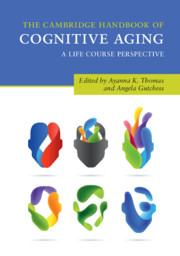Book contents
- The Cambridge Handbook of Cognitive Aging
- The Cambridge Handbook of Cognitive Aging
- Copyright page
- Contents
- Figures
- Tables
- Contributors
- Introduction
- Part I Models of Cognitive Aging
- Part II Mechanisms of Cognitive Aging
- Part III Aging in a Socioemotional Context
- Part IV Cognitive, Social, and Biological Factors across the Lifespan
- 23 Prenatal Influences on Cognitive Aging
- 24 Associations between Activity Participation across the Life Course and Cognitive Aging
- 25 Cognitive Aging and Culture: Older Brain Predictions about Different Environments
- 26 Current Perspectives on Aging and Bilingualism across the Life Span
- 27 Grit and Successful Aging
- 28 Control and Cognition: Contextual and Individual Differences in Cognitive Aging
- 29 Cognition and Well-Being across Adulthood and Old Age
- 30 The Genetics of Cognitive Abilities
- 31 Blood Biomarkers of Cognitive Health and Neurodegenerative Disease
- Part IV Summary: Early Life and Biological Factors
- Part V Later Life and Interventions
- Index
- Plate Section (PDF Only)
- References
29 - Cognition and Well-Being across Adulthood and Old Age
from Part IV - Cognitive, Social, and Biological Factors across the Lifespan
Published online by Cambridge University Press: 28 May 2020
- The Cambridge Handbook of Cognitive Aging
- The Cambridge Handbook of Cognitive Aging
- Copyright page
- Contents
- Figures
- Tables
- Contributors
- Introduction
- Part I Models of Cognitive Aging
- Part II Mechanisms of Cognitive Aging
- Part III Aging in a Socioemotional Context
- Part IV Cognitive, Social, and Biological Factors across the Lifespan
- 23 Prenatal Influences on Cognitive Aging
- 24 Associations between Activity Participation across the Life Course and Cognitive Aging
- 25 Cognitive Aging and Culture: Older Brain Predictions about Different Environments
- 26 Current Perspectives on Aging and Bilingualism across the Life Span
- 27 Grit and Successful Aging
- 28 Control and Cognition: Contextual and Individual Differences in Cognitive Aging
- 29 Cognition and Well-Being across Adulthood and Old Age
- 30 The Genetics of Cognitive Abilities
- 31 Blood Biomarkers of Cognitive Health and Neurodegenerative Disease
- Part IV Summary: Early Life and Biological Factors
- Part V Later Life and Interventions
- Index
- Plate Section (PDF Only)
- References
Summary
Life-span theory has long emphasized that cognitive functioning and well-being are key constituents of successful development and aging. There is mounting empirical evidence that these central domains of life are closely intertwined, with better performance on a number of cognitive ability tests going hand in hand with higher levels of well-being and satisfaction. Less well understood, however, are the multiple different sets of pathways that underlie how and why well-being either represents a consequence of cognitive functioning and development or operates as an antecedent condition thereof. The major objective of the current chapter is to provide a select overview of (1) an exemplary set of mechanisms that help explain the often dynamic and reciprocal links between the two major areas of life and (2) the role that several layers of individual and contextual factors play as resources and constraints. To do so, we proceed in four steps. First, we review conceptual considerations and empirical evidence on stability and change in well-being from mid adulthood to very old age, the vast individual differences in levels and rates of change, and how these differences are shaped by cognitive functioning and change. Second, we consider how well-being may serve as an antecedent of functioning and development of cognitive performance and abilities. Third, we present stress reactivity, health behaviors, social participation, and neurological pathways as some of the presumed underlying processes. Finally, we discuss the role that resources and constraints at individual and contextual levels may play for linking cognition and well-being.
Keywords
- Type
- Chapter
- Information
- The Cambridge Handbook of Cognitive AgingA Life Course Perspective, pp. 532 - 551Publisher: Cambridge University PressPrint publication year: 2020
References
- 2
- Cited by

